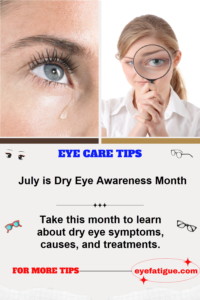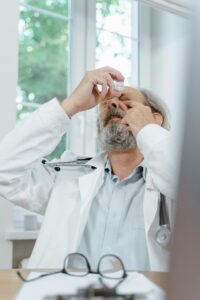Dry Eye Awareness Month: More Than Just a Blink-and-You’ll-Miss-It Issue
Ever feel like you’re walking through life with a pair of sandpaper eyeballs? Or maybe your eyes sting and water more than a rom-com marathon? If so, you’re not alone. Millions of people experience the gritty discomfort of dry eye, and July is dedicated to raising awareness about this surprisingly common condition.
EyeFatigue.com is passionate about eye health, so we’re shedding light (pun intended) on Dry Eye Awareness Month. Let’s delve into what dry eye is, the sneaky symptoms it can cause, who’s most at risk, and—most importantly—what you can do about it.
What is Dry Eye Disease (DED)?

Dry eye disease (DED), also known as dry eye syndrome, isn’t just about a lack of tears. It’s a complex condition where your eyes don’t produce enough tears or the right quality of tears to keep them properly lubricated. This can lead to many irritating and sometimes even painful symptoms.
Did you know that an estimated 16 million Americans suffer from DED? That’s a lot of sandpaper eyeballs! And it’s not just a matter of discomfort. If left untreated, DED can lead to eye infections and even vision problems.
Looking for stylish frames that won’t break the bank? Look no further.
Here’s a little-known fact: there are two main types of DED. Evaporative dry eye is the most common, and it happens when the oily layer of your tears evaporates too quickly. Aqueous deficient dry eye, on the other hand, occurs when your tear glands don’t produce enough watery fluid. Both types can leave your eyes feeling less than stellar.
The Sneaky Symptoms of Dry Eye
You probably know the classic dry eye symptoms: burning, stinging, itching, and a gritty sensation. But DED can be a chameleon, masquerading as other issues. Have you ever blamed your watery eyes on allergies or a late night out? It could be dry eye in disguise! Other sneaky symptoms include blurred vision, redness, light sensitivity, and stringy discharge.
Are your eyes feeling dry?
Check out our blog post: Are Your Eyes Feeling Dry?
Who’s at Risk for Dry Eye?
While anyone can develop dry eye, certain factors can increase your risk. Age plays a role, with DED becoming more common as we get older. Women, especially those going through hormonal changes, are also more susceptible.
Environmental factors like dry air, wind, and smoke can worsen dry eye symptoms. And if you spend a lot of time staring at screens (guilty!), you’re more prone to digital eye strain, which can contribute to DED.
Certain health conditions like diabetes, rheumatoid arthritis, and thyroid problems can also increase your risk. And surprisingly, some medications, including antihistamines, antidepressants, and blood pressure meds, can dry out your eyes.
Dealing with Dry Eye

The good news is that there are plenty of ways to find relief from dry eye. Simple home remedies like warm compresses, using a humidifier, and increasing your intake of omega-3 fatty acids can make a big difference.
Over-the-counter artificial tears, gels, and ointments can help lubricate your eyes and alleviate discomfort. Your eye doctor can recommend prescription medications or other treatments if these options aren’t enough.
Making a few lifestyle changes can also help keep your eyes happy. Take regular breaks from screens, practice blinking exercises to keep your eyes moist, and eat a healthy diet rich in omega-3s.
When to Seek Professional Help
If your dry eye symptoms are persistent, severe, or affecting your vision, seeing an eye doctor is essential. They can diagnose the underlying cause of your DED and recommend the best course of treatment.
If you wear contacts, make sure to read our blog post about the best contacts for dry eyes.
Conclusion
This Dry Eye Awareness Month, let’s make a conscious effort to prioritize our eye health. Remember, dry eye is more than just a minor annoyance. It’s a common condition that can significantly impact your quality of life.
By understanding DED’s causes, symptoms, and treatment options, you can take proactive steps to keep your eyes comfortable and healthy.
We hope you continue to explore the resources available on EyeFatigue.com for more information and support.
And if you’re struggling with persistent or severe dry eye, don’t hesitate to seek professional help. Your eyes will thank you!
